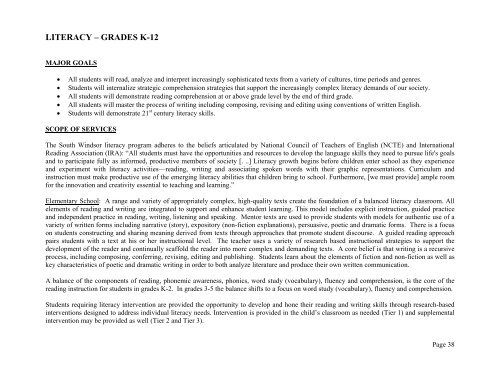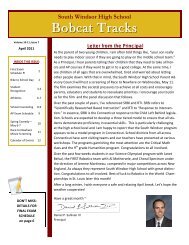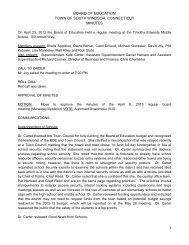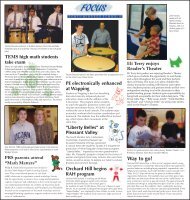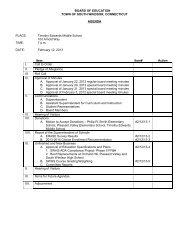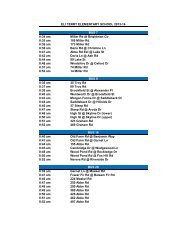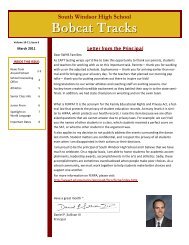2013-2014 Board of Education Proposed Budget Book
2013-2014 Board of Education Proposed Budget Book
2013-2014 Board of Education Proposed Budget Book
You also want an ePaper? Increase the reach of your titles
YUMPU automatically turns print PDFs into web optimized ePapers that Google loves.
LITERACY – GRADES K-12<br />
MAJOR GOALS<br />
• All students will read, analyze and interpret increasingly sophisticated texts from a variety <strong>of</strong> cultures, time periods and genres.<br />
• Students will internalize strategic comprehension strategies that support the increasingly complex literacy demands <strong>of</strong> our society.<br />
• All students will demonstrate reading comprehension at or above grade level by the end <strong>of</strong> third grade.<br />
• All students will master the process <strong>of</strong> writing including composing, revising and editing using conventions <strong>of</strong> written English.<br />
• Students will demonstrate 21 st century literacy skills.<br />
SCOPE OF SERVICES<br />
The South Windsor literacy program adheres to the beliefs articulated by National Council <strong>of</strong> Teachers <strong>of</strong> English (NCTE) and International<br />
Reading Association (IRA): “All students must have the opportunities and resources to develop the language skills they need to pursue life's goals<br />
and to participate fully as informed, productive members <strong>of</strong> society [. ..] Literacy growth begins before children enter school as they experience<br />
and experiment with literacy activities—reading, writing and associating spoken words with their graphic representations. Curriculum and<br />
instruction must make productive use <strong>of</strong> the emerging literacy abilities that children bring to school. Furthermore, [we must provide] ample room<br />
for the innovation and creativity essential to teaching and learning.”<br />
Elementary School: A range and variety <strong>of</strong> appropriately complex, high-quality texts create the foundation <strong>of</strong> a balanced literacy classroom. All<br />
elements <strong>of</strong> reading and writing are integrated to support and enhance student learning. This model includes explicit instruction, guided practice<br />
and independent practice in reading, writing, listening and speaking. Mentor texts are used to provide students with models for authentic use <strong>of</strong> a<br />
variety <strong>of</strong> written forms including narrative (story), expository (non-fiction explanations), persuasive, poetic and dramatic forms. There is a focus<br />
on students constructing and sharing meaning derived from texts through approaches that promote student discourse. A guided reading approach<br />
pairs students with a text at his or her instructional level. The teacher uses a variety <strong>of</strong> research based instructional strategies to support the<br />
development <strong>of</strong> the reader and continually scaffold the reader into more complex and demanding texts. A core belief is that writing is a recursive<br />
process, including composing, conferring, revising, editing and publishing. Students learn about the elements <strong>of</strong> fiction and non-fiction as well as<br />
key characteristics <strong>of</strong> poetic and dramatic writing in order to both analyze literature and produce their own written communication.<br />
A balance <strong>of</strong> the components <strong>of</strong> reading, phonemic awareness, phonics, word study (vocabulary), fluency and comprehension, is the core <strong>of</strong> the<br />
reading instruction for students in grades K-2. In grades 3-5 the balance shifts to a focus on word study (vocabulary), fluency and comprehension.<br />
Students requiring literacy intervention are provided the opportunity to develop and hone their reading and writing skills through research-based<br />
interventions designed to address individual literacy needs. Intervention is provided in the child’s classroom as needed (Tier 1) and supplemental<br />
intervention may be provided as well (Tier 2 and Tier 3).<br />
Page 38


